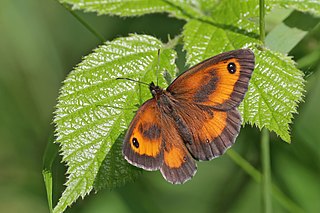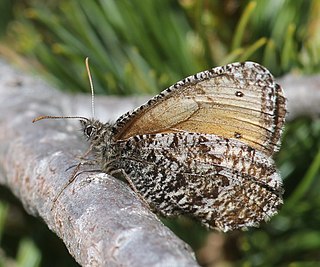
The Tanana River is a 584-mile (940 km) tributary of the Yukon River in the U.S. state of Alaska. According to linguist and anthropologist William Bright, the name is from the Koyukon (Athabaskan) tene no, tenene, literally "trail river".

The gatekeeper or hedge brown is a species of butterfly found across Europe. Given its preference for warmer weather, the restriction of range expansion can be assumed to be due to climate. Colonies vary in size depending on the available habitat, and can range from a few dozen to several thousand butterflies. Named for its rigorous patrol of hedges and woodland rides, the gatekeeper butterfly is a prime pollinator.

The forest ringlet, also known as Helms' butterfly, or te pēpepe pōuri or pepe pouri in the Māori language, is a rare butterfly of the family Nymphalidae endemic to New Zealand. It is the only species in the genus Dodonidia.

The Satyrini is one of the tribes of the subfamily Satyrinae. It includes about 2200 species and is therefore the largest tribe in the subfamily which comprises 2500 species.

Agrias is a genus of Neotropical charaxine nymphalid butterflies found in South and Central America.

The butterfly subtribe Euptychiina is a diverse group within the tribe Satyrini, occurring throughout Central and South America, in addition to a few species known from North America. Euptychiina is a predominantly lowland group, with the exception of one Asian taxon Palaeonympha opalinaButler, 1871 and the Andean genus ForsterinariaGray, 1973. The taxon was erected by Lee Denmar Miller.

Oeneis is a butterfly genus of the Satyrinae. All but one of its members are Arctic, sub-Arctic or high-altitude alpine in distribution. Some of the members of the genus are among the butterflies that can get along in the harshest climates of any butterflies. Four species in Europe, more are found in Arctic Russia, Siberia, Mongolia, Arctic North America and the Rocky Mountains. Curiously, there are no observations from Greenland. The development of most species takes two years.

Papilio appalachiensis, the Appalachian tiger swallowtail, is a species of swallowtail butterfly found in eastern North America, particularly in the Appalachian Mountains. It is a hybrid of another two Papilio species, Papilio canadensis and Papilio glaucus, with which it shares many characteristics. The butterflies are normally yellow and contain black patterns in their wings. Their wingspans range from 86 to 115 mm. The caterpillars range in color from green and yellow to orange and are ornamented with black specks that give them the appearance of a bird dropping, which is useful for camouflage, or a large eye, a form of mimicry that is also efficient for protection. This species is univoltine. Females lay their eggs in May.

Oeneis chryxus, the chryxus Arctic or brown Arctic, is a butterfly of subfamily Satyrinae found in the far northwest regions of Canada and the United States. The brown Arctic has highly variable colorings, which tend toward light yellow to orange brown wings that help camouflage it against its mountainous rocky habitat. The larvae feed on local grasses and take two years to develop. This longer development period results in flights of adult brown Arctics only once every two years. The butterflies feed on nectar from various plants as their primary food source.

Oeneis jutta, the Jutta Arctic or Baltic grayling, is a species of butterfly in the subfamily Satyrinae with a Circumboreal distribution. It occurs in bogs and tundra in the north of Europe, the Baltic states, the Urals, Siberia, northern Kazakhstan, the Russian Far East, northern Mongolia, northeastern China, North Korea, and northern North America. Larvae feed on Carex and Eriophorum, possibly also Glyceria, Molinia, and Juncus. Ledum palustre is the preferred nectar plant of the adult butterflies. The species has one generation every one or two years, depending on the location.

Oeneis norna, the Norse grayling, is a species of butterfly in the subfamily Satyrinae, that occurs throughout Scandinavia and the northern Palearctic.
Oeneis alpina, the sentinel Arctic or Eskimo Arctic, is a species of butterfly in the subfamily Satyrinae. It occurs in Siberia and the northern parts of North America.

Euphyes dukesi, or Dukes' skipper, is a butterfly of the family Hesperiidae. It lives in the eastern United States and in a small portion of southern Ontario, Canada, in three distinct populations. Preferred habitats are shaded wetlands, with various species of sedge plants it uses as host plants for its larvae.

The Tanana Athabaskans, Tanana Athabascans, or Tanana Athapaskans are an Alaskan Athabaskan people from the Athabaskan-speaking ethnolinguistic group. They are the original inhabitants of the Tanana River drainage basin in east-central Alaska Interior, United States and a little part lived in Yukon, Canada. Tanana River Athabaskan peoples are called in Lower Tanana and Koyukon language Ten Hʉt'ænæ, in Gwich'in language Tanan Gwich'in. In Alaska, where they are the oldest, there are three or four groups identified by the languages they speak. These are the Tanana proper or Lower Tanana and/or Middle Tanana, Tanacross or Tanana Crossing, and Upper Tanana. The Tanana Athabaskan culture is a hunter-gatherer culture with a matrilineal system. Tanana Athabaskans were semi-nomadic and lived in semi-permanent settlements in the Tanana Valley lowlands. Traditional Athabaskan land use includes fall hunting of moose, caribou, Dall sheep, and small terrestrial animals, as well as trapping. The Athabaskans did not have any formal tribal organization. Tanana Athabaskans were strictly territorial and used hunting and gathering practices in their semi-nomadic way of life and dispersed habitation patterns. Each small band of 20–40 people normally had a central winter camp with several seasonal hunting and fishing camps, and they moved cyclically, depending on the season and availability of resources.

Carla Maria Penz is a butterfly comparative morphologist and systematist, and the Doris Zemurray Stone Chair in Biodiversity at the University of New Orleans. Her research also focuses on natural history and behavior, mostly of neotropical butterflies.

Oeneis bore, the white-veined Arctic or Arctic grayling, is a butterfly, a species of Satyrinae that occurs in North America and Asia.
Oeneis macounii, the Canada Arctic or Macoun's Arctic, is a butterfly of subfamily Satyrinae that occurs in North America.
Oeneis rosovi, the Philip's Arctic or early Arctic, is a species of butterfly in the subfamily Satyrinae. It occurs in Siberia and the northern parts of North America.
Oeneis polixenes, the Polixenes Arctic or Norique Alpin, is a species of butterfly in the subfamily Satyrinae. It has a Circumpolar distribution occurring in northern parts of North America the Arctic Urals, Kamtchatka, Yakutia, Chukchi Peninsula, and northern Siberia.
Erebia pawloskii, the yellow-dotted alpine, is a member of the subfamily Satyrinae of the family Nymphalidae. It is found in North America in northern British Columbia, Yukon, and Alaska. It is also found in the Sayan Mountains, and from northern Mongolia to Yakutia and Kamchatka. The habitat consists of grassy areas in and above wet tundra, as well as bogs.















